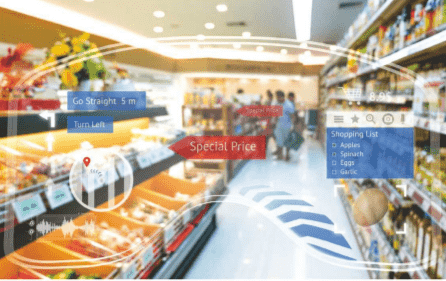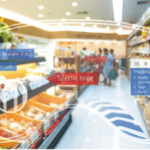Technology is the tool that serves customer wishes, writes Chloe Rigby
AS RETAILERS PUT the customer front and centre of their operations in an increasingly competitive retail environment, new data-powered insights are helping them do it. Being able to understand what a customer wants to buy, how they want to buy and how they might buy in the future –this is the information that enables traders to give their shoppers an experience that works for them, whether they’re searching for a product, contacting a retailer or returning an item they no longer want. But at the moment, there’s still a gap between the aspiration to use data to improve customer service and the customer experience itself.
Alastair Sterling, industry head, retail at Google UK , showed the scale of the challenge – and the opportunities – when he spoke at InternetRetailing Conference (IRC 2017) this autumn. “Every two days, we produce more data than mankind produced up to 2003,” he said. “For businesses, that’s mind-blowing. On one side of the fence this is scary but on the other, if I can make sense of that data, I’m probably going to be able to engage with my consumers, my audience, better than ever before, and give them new experiences as well.” While retailers have new opportunities to use their data, customer expectations stay ahead of them, Sterling notes.
Getting to know the customer
In their mission to understand the customer, retailers are deploying a wide-ranging tool kit. They’re building their single view of the customer in order to understand past and current behaviour and to predict how they’d like to be served in the future. One key goal is to keep the customer experience consistent across channels through a journey that may move from desktop to mobile, to store and beyond. Achieving this means gaining real insights, such as whether a retailer’s customers prefer to shop via app, or visit the desktop website before heading into the store.
It’s a tough task, as Halfords pointed out when it said in half-year results to 29 September 2017 that it could by then match 54% of its retail transactions to its customers – significantly ahead of the 3% it could match two years previously. That’s no mean feat considering the scale of the challenge. In the last two years alone, the automotive-to-cycling retail and services business said it had gathered 6.5m email addresses, which it reconciles with information coming in from 21 different data sources. The tools that helped, it said, included the use of e-receipts and tokenisation. Halfords is adding to that information with the use of a wide-ranging ‘Give us a steer’ survey that gets responses from 10,000 customers a week. This extra information, it says, gives it, “a more complete view of our customers so that we can become more relevant in their lives”. It’s using the information to personalise web experiences based on shoppers’ previous browsing and purchasing history. It also sends more than 25 different automated trigger emails to opted-in customers and says that it’s now able to infer, and act on, future milestones in customers’ lives, especially around children’s car seats and bicycles.
The results are clear. “Communicating in a more relevant and targeted way with the right product and at the right time is driving increased frequency of interaction between us and our customers,” Halfords report. “As a result of our work in this area, in the last six months, we have seen an incremental 1.5m visits to the website, driving additional revenue.”
Supermarket Sainsbury’s is also working to find out about its customers. It’s launched the Sainsbury’s Living Well Index, a long-term study that it hopes will help it better understand its customers. Sainsbury’s study aims to track what it means to live well in 21st century Britain. Oxford Economics worked with the National Centre for Social Research to interview 8,250 adults across the UK, measuring their wellbeing with a 60 question survey that covers how happy, satisfied and anxious people feel, as well as their sense of self-worth. It found that how people live is more important to their wellbeing than who they are, as defined through gender, age or education, and that quality of sleep, sex life and job security make the biggest difference to living well.
“The results of this, combined with our customer data, will influence some of the choices we make around how we best serve our colleagues, customers and communities in the future,” said Mike Coupe, group chief executive of J Sainsbury plc, in half-year results to 23 September 2017.
Keeping up with the customer
Shopping behaviour is changing so quickly that retailers that don’t get to know their customers and how they want to shop may miss emerging trends and changes in the way that they buy. Conversely, being the first to react to change can prove a real advantage.
Rakuten Europe president Arjen van de Vall says that fast-developing social and mobile technologies are changing both shopping habits and shoppers’ expectations. “The pace of these changes is truly impressive,” he said. “The biggest dynamic that is changing is that the customer is more and more in charge. This forces retailers to evolve and innovate, but also to find the right partners that allow them to become competitive and to address customer needs. The market is evolving fairly rapidly. I think in general, we as consumers have access to more buying opportunities than ever before and that customers and consumers are also becoming smarter and smarter when it comes to making purchase decisions. They decide when, where and how to buy. They set the terms.”
That means, he says, that retailers are now responding, often being forced to do so by the pace of change, with new experiences based on service, availability and timeliness that goes beyond mere conversion. “You need to deliver the best quality of service at all times during the cycle,” says van de Vall.
“The biggest dynamic that is changing is that the customer is more and more in charge, which forces retailers to evolve and innovate” Arjen van de Vall, Rakuten Europe
One retailer that’s facing changes in the way its customers buy is Clarks . Giles Delafeld, global CIO at the shoe retailer and manufacturer said at IRC 2017 that the retailer has several key groups of customers, some more traditional, and some less so. Traditional groups include parents with their children and older people looking for comfortable shoes. But the Clarks Originals range also has a certain cachet among LA rap stars, and hence, millennials and the newer ‘I’-generation.
As it responds to the needs of its different audiences, Clarks has moved to a mobile-first platform, so Delafeld says a digital mindset is now a prerequisite. “Organisations need to be working at least as fast as consumers, if not faster,” he says. And that means “testing, and creating new customer value propositions rapidly in order not just to be relevant but to stay ahead”. Delafeld also sounds a note of caution. “Having the labels is a useful conversation starter but in the end, you need to know who you are, and who consumes your product,” he said. It’s important not to generalise, he adds, noting that it would be dangerous to assume that all customers want to move between devices in real-time or to communicate only online.
The emerging retail response
As retailers start to understand their shoppers better, they’re coming up with new responses. They’re not only offering experiences that are personalised to them but are also starting to consider the emotional effects of commerce too. Emotional commerce, says Google’s Alastair Sterling, leads to “sticky” consumers, who “go out of their way to engage with the brand”. He cites Screwfix as an example. “This is a business that has redefined the user experience through technology and it’s doing well for them.”
“Our virtual experiences will be driven by our emotions as facial recognition monitors and understands what we’re looking at and why we’re doing so” Sophie Hackford, futurist
By considering how people will react emotionally to different elements on the website, leading retailers are finessing significant details of the customer experience. Sean McKee, head of ecommerce at shoe retailer Schuh , speaking in a debate on emotional commerce at IRC 2017, said that it measures customer sentiment with every transaction. He added, “It’s not just about today’s sale but about being where the customer trusts you. I don’t think it’s coincidental the conversion you get by putting people ahead of customers.” Measures that appeal to emotions and that work on its website, he said, include live chat, a countdown clock telling shoppers how long they have left to place their order for next-day delivery, and buttons that shoppers can push in order to share a product with their friends. Simon Bell, founder and managing director of ecommerce agency Diligent Commerce, also speaking in the IRC 2017 debate on emotional commerce, said that getting it right is all about storytelling. “Tell a story, tell me why you exist and get me to buy into the brand before I will buy your products.”
Looking to the future customer
As the real world becomes searchable by computer and as artificial intelligence develops, futurist Sophie Hackford sees two different kinds of reality coming into play in retail environments: augmented reality and virtual reality. Augmented reality will take the form of a computer overlay to the real world, using smartphone and other screens to navigate around the world, including around shops. “Screens now dominate the world and we’re moving into a moment when we won’t just look at the screen but through the world and see it annotated and tailored to our needs,” said Hackford, speaking at the SAP Hybris Live Global Summit in Barcelona this autumn. Beyond that, hyper reality might see this augmented view transferred to an overlay that people view even when they’re not looking at a screen.
Beyond that again, virtual reality, with virtual places that people will go and visit will, believes Hackford, define the eventual future of the internet. “All of this will be driven by our data, although our virtual experiences will be driven by our emotions, by how we feel, as facial recognition monitors and understands what we’re looking at and why we’re doing so. But it’s also going to help us understand it as well.” In retail, she envisages a virtual photo-real supermarket where shoppers can use their hands to pick up items from a range of millions as they do their shopping virtually. Such moves might mean the end to the phone as the headset replaces the screen.
Yet all this could be a long way off. After all, says Hackford, full digitisation of the world is still far off. But considering it now certainly serves to remind retailers that the ways they sell will continue to change, and that this change will be led by the customer and the ways they choose to use any kind of emerging technology.






